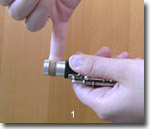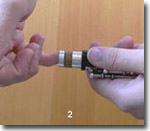- A new instrument must not get too moist during the first months of use, and it must be well pulled through/swabbed during breaks to remove excess moisture..
- During the period when central heating is used you should not play for more than one hour a day, and in the summer not for more than two hours; this period should then gradually be increased.
- Basically you should hold and put down the flute in such a way that no water can flow into the tone holes; water usually gets into the tone holes when the line of condensation which forms in the inner bore during playing runs through the tone holes.
- Most damage to the mechanism occurs when putting the flute together or taking it apart.
Whereas the mechanism on metal flutes is soldered to the tube, on wooden flutes it is attached to the body by means of small wood screws. It is therefore especially important to adhere to the above instructions to avoid causing any damage. The same naturally also applies to piccolos.


